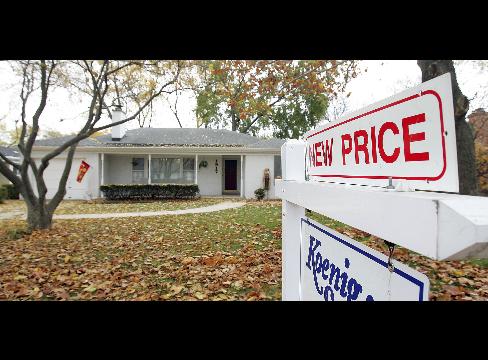
A new price sign stands atop a sign outside a home in Park Ridge, Illinois, on Nov. 6, 2008. Photographer: Tim Boyle/Bloomberg News
Nov. 25 (Bloomberg) — House prices in 20 U.S. cities declined in the year ended in September at the fastest pace on record as rising foreclosures pushed down property values.
The S&P/Case-Shiller home-price index dropped 17.4 percent in September from a year earlier, more than forecast, after a 16.6 percent decline in August. The gauge has fallen every month since January 2007, and year-over-year records began in 2001.
Mounting foreclosures are contributing to the drop in home prices, while adding to the inventory of unsold homes on the market. Lower property values are weighing on household wealth, causing consumers to cutback on spending and increasing the likelihood that the U.S. economy will contract for a second consecutive quarter.
“The onslaught of foreclosures hitting the market is certainly one reason prices are falling and will continue to fall,” said Guy LeBas, chief economist at Janney Montgomery Scott LLC in Philadelphia, who forecast a 17.1 percent drop. “We need to purge the excesses of the last several years, and the only way to do that is to suffer through these home price declines.”
Home prices decreased 1.8 percent in September from the prior month after declining 1 percent in August, the report showed. The figures aren’t adjusted for seasonal effects so economists prefer to focus on year-over-year changes instead of month-to-month.
GDP Declines
A government report showed the U.S. economy shrank in the third quarter faster than previously estimated as consumer spending plunged by the most in almost three decades. Gross domestic product contracted at a 0.5 percent annual pace from July through September, the most since the 2001 recession, according to revised figures from the Commerce Department today in Washington. The government’s advance estimate issued last month showed a 0.3 percent decline.
S&P/Case-Shiller also released quarterly figures for nationwide home prices. That measure showed a 16.6 percent drop in the three months through September from the previous three months, compared with a 15.1 percent drop in the second quarter.
Economists forecast the 20-city index would fall 16.9 percent from a year earlier, according to the median of 28 estimates in a Bloomberg News survey. Projections ranged from declines of 16 percent to 17.2 percent.
Compared with a year earlier, all areas in the 20-city survey showed a decrease in prices in September, led by a 31.9 percent drop in Phoenix and a 31.3 percent decline in Las Vegas.
Condo Values
Separately, S&P/Case-Shiller released a new component that tracks condominium values in Boston, Chicago, Los Angeles, New York and San Francisco on a monthly basis dating back to 1995. The seasonally adjusted index shows September prices in the five cities declined 10 percent from a year ago, led by a 20 percent drop in Los Angeles.
“The turmoil in the financial markets is placing further downward pressure on a housing market already weakened by its fundamentals,” David Blitzer, chairman of the index committee at S&P, said in a statement.
Robert Shiller, chief economist at MacroMarkets LLC and a professor at Yale University, and Karl Case, an economics professor at Wellesley College, created the home-price index based on research from the 1980s.
Foreclosures
Reports this month showed mounting foreclosures are pushing prices down and hurting demand. Existing home sales, which account for about 90 percent of the market, dropped in October and prices fell by the most on record, the National Association of Realtors said yesterday.
The median price of an existing home plunged 11.3 percent in October from a year earlier and fell to the lowest level since March 2004, according to the Realtors.
Sales of distressed properties accounted for 45 percent of last month’s total, up from about 40 percent in September, the agents’ group also said. Foreclosure filings were up 25 percent in October from a year ago, according to RealtyTrac Inc., the Irvine, California-based seller of default data.
Karl Case, the Wellesley College economics professor who co-created the index, said lower-priced homes have to be cleared from the market through foreclosure auctions to make way for recovery.
“The lower tier of borrowers, who are struggling to make ends meet, that’s the part of the market that needs to get cleared by auctions,” Case said in an interview with Bloomberg Radio. “That’s the difficult part.”
The drop in home construction has subtracted from growth since the first quarter of 2006. The downturn is likely to remain a drag on the economy until the home sales and prices improve.
D.R. Horton Inc., the largest U.S. homebuilder, reported its sixth straight quarterly loss today. The Fort Worth, Texas- based company said orders fell 38 percent while the cancellation rate was 47 percent.
To contact the reporter on this story: Timothy R. Homan in Washington at [email protected]
Last Updated: November 25, 2008 10:14 EST
By Timothy R. Homan
Source: Bloomberg